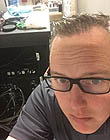|
|
This topic comprises 2 pages: 1 2
|
|
Author
|
Topic: Automation Suggestions
|
Brant Veilleux
Film Handler
Posts: 23
From: Chicago, IL, USA
Registered: Dec 2004
|
 posted 03-12-2007 08:43 PM
posted 03-12-2007 08:43 PM





Iíve got an install I am working on and am looking for some advice as to what Automation System I should look toward, or away from. I have not run across any systems that I am real impressed with in the few years I have been tech-ing. Though, most of the equipment I service is pretty old.
The newest automation system I have in the field is the Component Engineering TA-10. The system is pretty basic, which I like, but I have had a lot of boards go out on them. I also find that the operators donít clean the optics and most of them have the film presence and motion bypass switches on, which defeats the purpose of having automation.
The new theaters needs are not that complex, just the basics are needed, failsafe, lights, audio, projector, lamphouse, and fire alarm controls. My initial thought is to steer away from programmable queues and like complexities.
| IP: Logged
|
|
|
|
|
|
|
|
|
|
|
|
|
|
|
|
|
|
|
|
|
|
Jack Ondracek
Film God

Posts: 2348
From: Port Orchard, WA, USA
Registered: Oct 2002
|
 posted 03-19-2007 03:35 PM
posted 03-19-2007 03:35 PM





quote: Brant Veilleux
The newest automation system I have in the field is the Component Engineering TA-10. The system is pretty basic, which I like, but I have had a lot of boards go out on them. I also find that the operators donít clean the optics and most of them have the film presence and motion bypass switches on, which defeats the purpose of having automation.
Interesting. I've had no problems with the TA-10. Other than the board replacement you're talking about, it sounds like your problems have mainly been around the FM35 failsafe. In the past 5 years, I've had to clean mine once, and that was no big deal. They've been bulletproof ever since.
The bypass switch placement sounds like a training issue to me, though it's admittedly a way to get around a failsafe problem. You'll have challenges with that no matter what equipment you use, if the staff is allowed to take the covers off and play with the internals or if they can't get something fixed promptly.
| IP: Logged
|
|
Tristan Lane
Master Film Handler
Posts: 444
From: Nampa, Idaho
Registered: Feb 2002
|
 posted 03-19-2007 09:32 PM
posted 03-19-2007 09:32 PM




My experience with TA-10's has been pretty flawless. In fact, in 5 years, I believe the only parts I ever had to service was the occasional FM-35. They are pretty simple, for a solid state system. I can think of MUCH worse automations to use rather than TA-10's. TA-10's were extremely popular in the northwest.
If simplicity is your goal, go with a Christie 3Q. It can't get any simpler than that, (except a human being pushing buttons at the correct time). But I don't care for the Speco failsafes that are packaged with them (or any drop-switch failsafe for that matter. The wisest option would be to add a cue expander to give yourself more cues to work with.
If you are looking for flexibility in the future, Pennywise or Panalogic are the way to go. I service a theater with Panalogic automations, and it is evident that they had digital in mind when designing the model installed at this theater. Ironically, on houses where 35mm was removed entirely, a Pennywise DCA21 took its place. An equally good digital pegboard automation.
| IP: Logged
|
|
|
|
Jack Ondracek
Film God

Posts: 2348
From: Port Orchard, WA, USA
Registered: Oct 2002
|
 posted 03-20-2007 04:47 PM
posted 03-20-2007 04:47 PM





I'd have to agree with Sean... except for the part about Louis' automation, which I've not had the opportunity to try.
When I automated my booth, the goal was to duplicate what I would do, were I there to push the buttons. I got to take my "best show", and teach it to a computer, interfaced to a TA-10... and then duplicate it by 3... something I would NOT have been able to do myself.
Like building a print, the front-end of the week takes a certain amount of busywork... but once done, it puts out a polished presentation every time I push the button.
I'm also of the thought that one should be at the machines when starting... at least at the beginning of the night. As my double features are spliced on one platter, I will sometimes arm the mid-show restart and head downstairs... but even then, not very often. Old school, maybe... but I'm comfortable with the attitude.
I know some of you don't do it this way. If it works for you, fine. But I think this is where some of the attention to detail gets lost. If the setup doesn't force an operator to be there, some operators just won't be. If nobody's there to look at the focus when the machine starts, and that process is duplicated through the day in a multiplex, it's not hard to understand why things can look a little soft.
| IP: Logged
|
|
|
|
All times are Central (GMT -6:00)
|
This topic comprises 2 pages: 1 2
|
Powered by Infopop Corporation
UBB.classicTM
6.3.1.2
The Film-Tech Forums are designed for various members related to the cinema industry to express their opinions, viewpoints and testimonials on various products, services and events based upon speculation, personal knowledge and factual information through use, therefore all views represented here allow no liability upon the publishers of this web site and the owners of said views assume no liability for any ill will resulting from these postings. The posts made here are for educational as well as entertainment purposes and as such anyone viewing this portion of the website must accept these views as statements of the author of that opinion
and agrees to release the authors from any and all liability.
|

 Home
Home
 Products
Products
 Store
Store
 Forum
Forum
 Warehouse
Warehouse
 Contact Us
Contact Us




 Printer-friendly view of this topic
Printer-friendly view of this topic








![[Cool]](cool.gif)
![[Smile]](smile.gif)
![[Big Grin]](biggrin.gif) .
.






